Protection is an individual right and an individual responsibility. This statement shouldn’t be controversial in the slightest, but in recent years, an increasing number of politicians and lawmakers have expressed a belief that protection is solely the responsibility of the state. “Don’t take matters into your own hands,” they say. “Just call 9-1-1 and wait for help to arrive!” Thankfully, most of you can see the fallacy behind this statement. Rather than resigning ourselves to helpless victimhood, each and every one of us should become a trained protector and a first responder, even if it’s only to buy a little time until law enforcement, paramedics, or other professionals arrive.
This mission statement formed the backbone of Protector Symposium, a multi-day training program that’s currently on its fifth iteration. In September 2022, we attended Protector Symposium 5.0 in Tucson, Arizona, with the goal of absorbing knowledge from renowned experts in the protection industry. Attendees included members of the military, law enforcement officers, EMTs, firefighters, executive protection specialists, cybersecurity analysts, and preparedness-minded civilians. The event’s website explains, “The Protector Symposium is specifically designed for those who have a heart for protecting others and understand the tremendous value that comes from investing in life-saving skills.”
The Mindset of a Protector
Before we headed onto the training grounds for practical exercises, the event began in the classroom with an opening statement by Protector Symposium and Protector Nation founder Byron Rodgers. This was followed by presentations from each of the instructors.
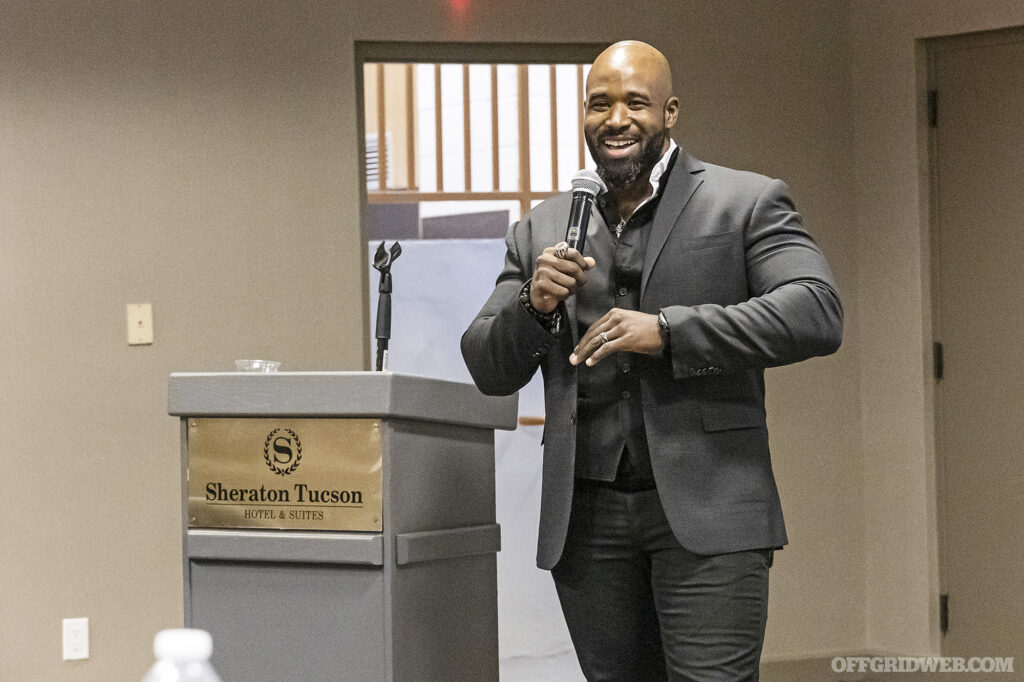
Craig “Sawman” Sawyer, a former Navy SEAL and founder of Veterans for Child Rescue (V4CR), opened with a frank discussion of the often-uncomfortable realities of being a protector. Sawyer reminded us of the old axiom, “evil prevails when good men do nothing,” but explained that simply doing something isn’t enough. As protectors, we must be righteously motivated and decisive. He continued, “Evil does not yield to mild suggestion. It never does. It takes and it destroys.” In practical terms, this means that those who are motivated to cause harm to others — rapists, murderers, and other ruthless predators — will not be swayed by polite requests or pleas for mercy. To reinforce this point, Sawyer shared an incident that rocked his family to the core. In 2017, Sawyer’s teenage daughter was abducted at knifepoint while walking out of a Subway sandwich restaurant in Tucson. Her abductor, later identified as 32-year-old Johnny Angel Salazar, forced her to walk with him to a dark and secluded area where he sexually assaulted her multiple times. Despite this horrific, life-altering event, Aspen Sawyer became a protector — a “right fighter,” as Sawman puts it. Today, she assists in V4CR operations to arrest predators and help victims of sex trafficking.
Sawyer left us with a powerful message: we should train hard to be better protectors because our lives depend on it, but more importantly, because others’ lives do. “There is a tremendous opportunity for you to make an impact and defend the defenseless,” he said.
Behind the Wheel
The next speaker was Rick Sweeney, President of SECFOR International and Director of the League of Executive Protection Specialists. With nearly 30 years of experience providing safety solutions for NGOs overseas, Sweeney has become an expert in vehicle-based operations in high-risk environments such as Bosnia, Iraq, Syria, and the war-torn Nagorno-Karabakh region.
Sweeney explained that many life-threatening scenarios, such as kidnappings and robberies, begin with a vehicle ramming attack or block-in tactics. To prove that this isn’t only a threat in foreign countries, he played a video of a 2022 armed robbery in Manhattan that began with a suspect using a stolen Mercedes to spin the victim’s car — not once, but twice — with a law-enforcement-style PIT maneuver:
Sweeney says in situations like this, your vehicle can serve as a powerful weapon as well as your best method of escaping to safety, but you’ll need to know how to use it effectively. Every driver is conditioned to avoid making contact with other cars, but you’ll need to get comfortable with trading some paint if you expect to escape this type of attack. In extreme cases such as those Sweeney has experienced overseas, it may also be necessary to PIT maneuver vehicles, evade obstacles at high speed, and push through roadblocks.
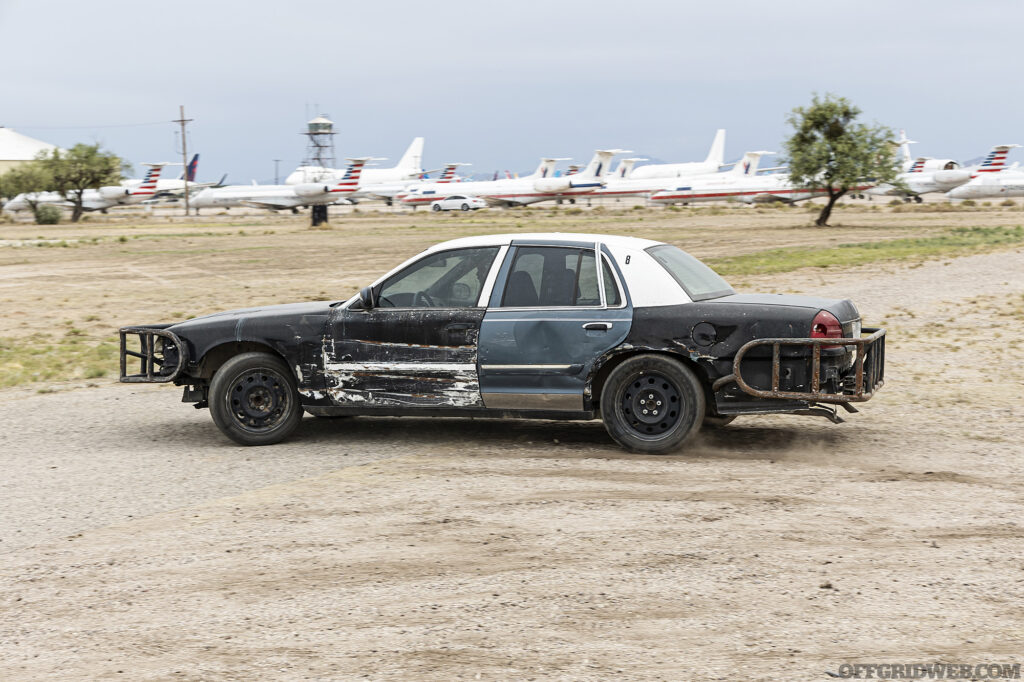
Above: Training vehicle used during the Protective Driving Course.
Protector Symposium 5.0 offered a two-day Protective Driving Course option that allowed students to practice evasive maneuvers and bumper-to-bumper “sparring” in specially modified Crown Victorias. However, this option overlapped with the two-day Hard Skills Intensive training we planned to attend, so we’ll have to take this course with Sweeney and the League at a later date. Stay tuned for an article about this program in the future.
Instructor Zero, a firearms training specialist and social media personality, also taught a training block related to fighting in and around vehicles.
Weaponology
Ed Calderon should be a name that’s very familiar if you’ve been following our magazine for the past few years. We interviewed Calderon about “Survival Lessons from South of the Border” back in RECOIL OFFGRID Issue 25 and published a dozen articles about his training courses since then. He has also written several original articles for us based on his experience working counter-cartel operations in Mexico. At one point in his career, his team was recovering 10 to 20 dead bodies every night, many of which were viciously mutilated or suspended from bridges as an intimidation tactic. Looking back at those nightmarish days on the streets of Tijuana, he recalled a quote: “enlightenment is a destructive process.” Those traumatic experiences helped him develop his protector philosophy and create courses to share real life-saving skills with other protectors.
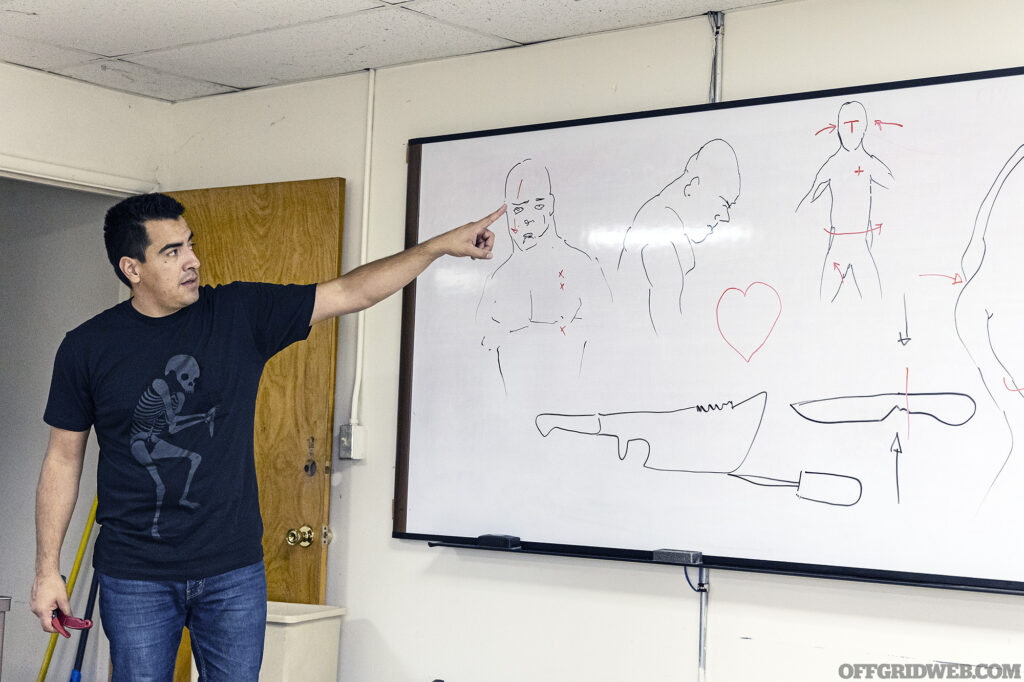
Above: Ed Calderon used whiteboard drawings to show vulnerable areas on the human body. Defensive knife designs were also discussed at length; wide and ornate blades are generally ineffective, while simple paring knives and icepicks are brutally efficient.
Calderon’s hard skills training block focused on weapon-based combatives, a curriculum he refers to as Weaponology. During the introduction, he explained, “There’s no such thing as blade combatives or gun combatives. Don’t separate sh*t. It’s a fight — you use what you have.” In other words, during a real life-and-death scenario, you won’t be concerned with which tool you’re using because you’ll be using every tool you have to stay alive. That said, there are some key characteristics for edged weapons that Calderon prefers. The handle should be simple in its design and should fit comfortably into a full-fist “icepick” grip (tip down) or “hammer” grip (tip up). The blade should be roughly the length of the user’s outstretched thumb and terminate in a narrow piercing point; Calderon has a strong dislike for karambits and other ornate blades. He considers an inexpensive Morakniv fixed blade to be one of the best knives on the planet — “it’s made as a tool, and it won’t break.” Paring knives from the grocery store are another favorite choice for utilitarian self-defense; they can be acquired in non-permissive areas and tossed in a trash can when you leave.
For the practical segment of Calderon’s course, students stepped into a padded sparring area, and each was handed an aluminum training knife. In pairs, we worked various angles and targeted weak points such as the heart and femoral artery. Calderon also showed us some down-and-dirty techniques for disrupting an opponent:
- Grabbing a knee and lifting to throw them off balance
- Stepping forward rapidly to pin their foot onto the ground, and shoving to topple them backward
- Pulling their shirt collar up over their head to completely block their vision
- Quickly passing the blade from one hand to another to make it more difficult to trap the weapon
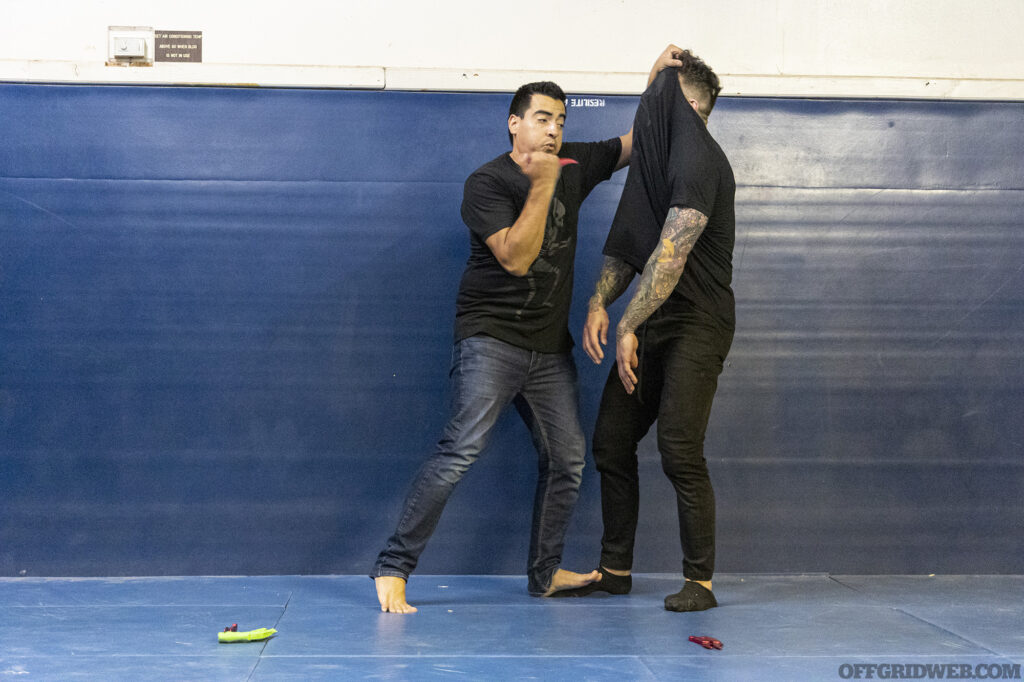
Above: Ed Calderon demonstrating how a disorienting shirt grab can be used as an opening to go on the offensive.
We also covered what Calderon refers to as “parting gifts” — attacks that can be used as you step past an adversary without slowing down, such as a quick eviscerating slash across the waistline. Some might look at these techniques and think, “These seem awfully brutal, more suitable for street thugs than self-defense. Why would you even teach this?” Calderon’s response is concise: “These techniques are already out there. If you’re not aware, you’re fighting yesterday’s war.” Also, whether you plan to use these methods or not, it’s important to experience them firsthand in training so you can formulate better defensive strategies. As for demeaning labels like “thugs,” Calderon offered another important lesson: “Never make the mistake of dehumanizing the enemy. It blinds you to his capabilities.”
Lone Operator Tactics
Let’s make something perfectly clear. CQB — close quarters battle, especially room-clearing — should be a group activity under ideal circumstances. Whether it’s a military unit or a SWAT team, there’s a reason you’ll see breaching teams stacked several members deep. When you’re attempting to clear a building all alone, you won’t be able to cover all the angles completely, and if you get injured, there won’t be anyone to return fire or drag you to safety. There’s no delegation of tasks or sectors of fire — it’s all on you. Knowing this, there are many who will say, “I’d never attempt to clear a building alone! That’s too dangerous!” To these individuals, we’d like to pose a hypothetical scenario.
You awake in the night to screams of terror coming from your 8-year-old daughter’s bedroom down the hall. As you sit bolt upright in bed, you hear a strange man’s voice shout “shut up, bitch” followed by more muffled screams. Your spouse is out of town, so you’re alone. There’s no way to know how many people are in the house, or if they’re waiting around a corner to ambush you. Do you: A) grab a gun and move swiftly to your daughter’s bedroom, or B) call 9-1-1 and hide until police to arrive, because solo CQB is too dangerous? There’s no question which option we’d choose. This is why it’s important to consider one-man CQB skills — it’s far from ideal, but there are situations where it may be necessary.
Kawa Mawlayee — an Afghan-born Green Beret and founder of 2Alpha Training Group, who we interviewed in Issue 52 — has developed a Lone Operator curriculum to teach students how to increase their survivability in a solo CQB environment. This skill is directly applicable to defense against home invasions, and it should be part of a cohesive plan that’s discussed in advance with everyone in your house. Typically, developing CQB skills requires weeks or months of continuous practice, so Mawlayee gave us a quick overview of the fundamentals during his Protector Symposium segment.
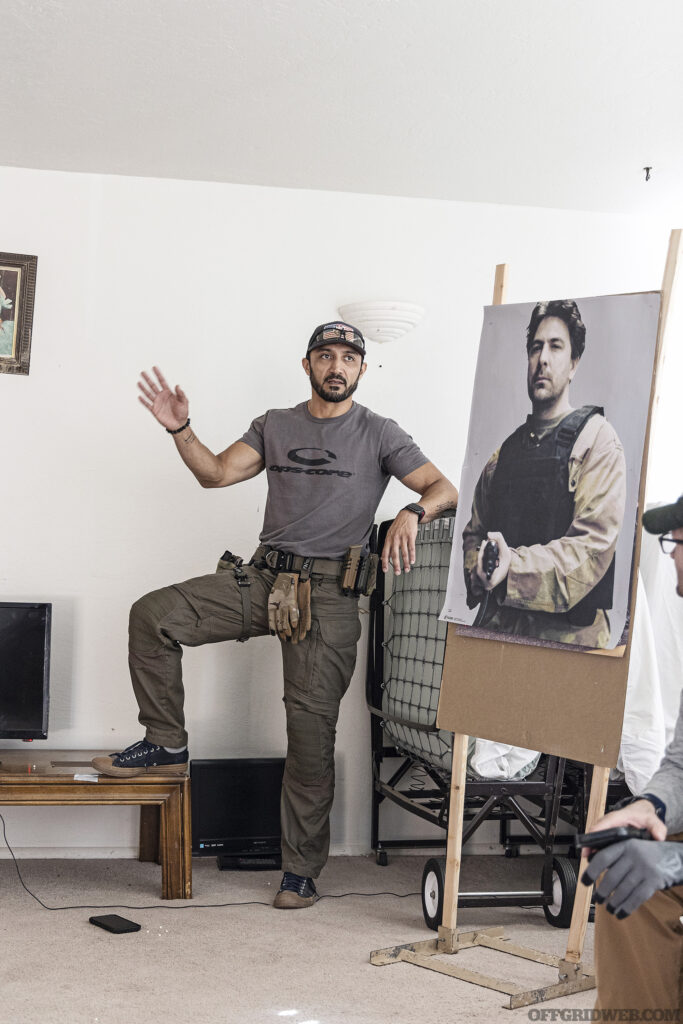
Above: Kawa Mawlayee spent an enormous amount of time practicing CQB skills as a Green Beret, and he takes pride in passing that knowledge to prepared civilians.
We practiced three approaches to checking doorways — non-entry, shallow entry, and deep entry. For a non-entry approach, we carefully walked up to one side of the doorway and leaned close to the wall to get as much view of the interior as possible. Then we moved slowly in a 180-degree arc to “slice the pie” and check for threats; a lean-step-lean-step motion was used to limit exposure. It’s critical to ensure the gun’s muzzle never protrudes past the threshold. We held our trainer guns barely below line of sight, ready to fire at a moment’s notice, and moved our guns in line with our eyes — in CQB, there’s no sense in moving your head to check an area without being able to shoot in that direction. More time and focus should be given to areas with dead space, such as large pieces of furniture someone could hide behind. If you decide not to make entry, you should keep moving as soon as you’ve established that the room is clear. Don’t get bogged down.
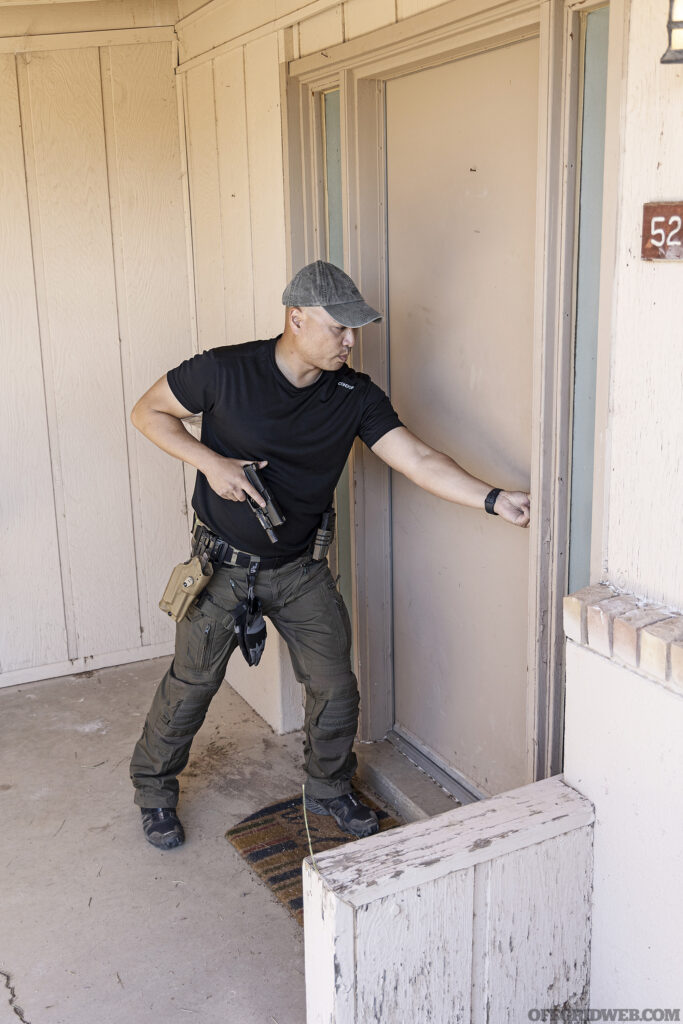
Above: Opening a closed door is a dangerous moment. Push (or pull) it open in one swift motion, using the precise amount of force necessary — too little and it’ll get in the way as you enter; too much and it’ll swing shut in your face.
With a shallow entry, you can establish a quick foothold in the room, buying yourself a few seconds to breathe and get out of “bullet funnel” areas like hallways. Mawlayee explained that bullets skip down halls like rocks on a lake, so you should avoid lingering there. We practiced arcing back to the center of the doorway, positioned a leading foot just outside the threshold, and then stepped swiftly through the doorway with body and gun at the same time, clearing the wall parallel to the threshold. Once that side was clear, we made a quick U-turn to clear the opposite wall and complete the shallow entry.
Deep entry can be used if you’re looking for a known threat or a specific asset (e.g., a trauma kit, a defensible place to barricade, or a path to an emergency exit). The process is the same as shallow entry, but after the U-turn, we moved along the perimeter of the room to look for points of dominance (POD; key areas you can control for a strategic advantage). Check for open and closed doors — open doors are a priority and should be cleared first — and also note the hinge placement to predict the entry/exit direction. If you need to open a closed door, stay close to the wall, open it quickly and completely, and immediately step back. Anyone inside may fire blindly into the doorway or the wall next to it, so you don’t want to be where they’ll expect you.
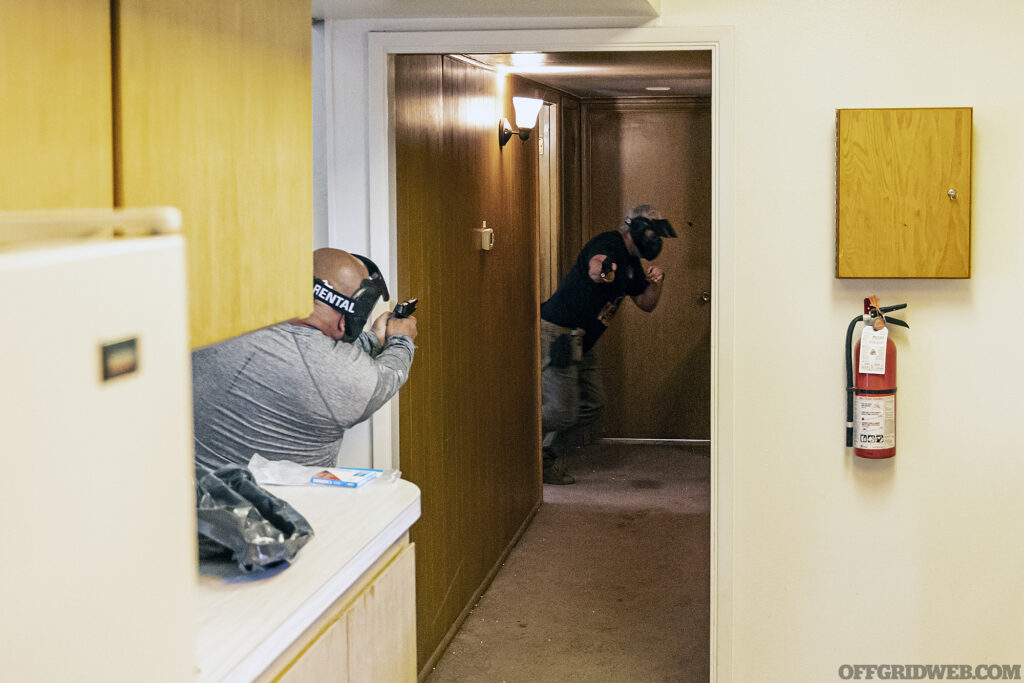
Above: Airsoft guns may be marketed as toys, but they’re great tools for practicing force-on-force scenarios in close quarters.
After practicing these techniques, we put on masks and loaded up airsoft guns. Each student was tasked with clearing a series of rooms, with randomized configurations of opponents and bystanders inside. If a bystander approached, we gave clear verbal commands to stay back, show hands, and leave through a safe area, never allowing them to get close enough to snatch our guns. Some of the “bad guys” in our scenarios were instructed to hide for an ambush, surrender immediately, fire blindly, or retreat further into the structure after first contact. We learned firsthand how solo CQB situations are unavoidably dangerous, but we also saw that good visual awareness, wise decision-making, and violence of action can improve your chances of survival.
Hands-On with a Handgun
It should come as no surprise that self-defense shootings typically occur at “conversational distance” — less than 7 yards, the distance at which we usually interact with other people. Most of us also know how easy it is for a motivated attacker to lunge forward and close that gap. This leads to a high likelihood that an adversary will try to block you from drawing your gun, redirect the gun, or worst of all, attempt to take it from you and shoot you with it. Most shooters are not adequately prepared for this hands-on fight.
Raul Martinez is a U.S. Army veteran, former undercover narcotics officer with the Chicago Police Department, and founder of Rogue Methods, a combatives training organization. He leveraged his experience in Iraq and on some of the roughest streets in America to teach us how to deploy, retain, and recover a firearm at contact distance. He made it clear that a hands-on fight with a gun in play is a worst-case scenario, but also one you must be prepared for if you carry a gun.
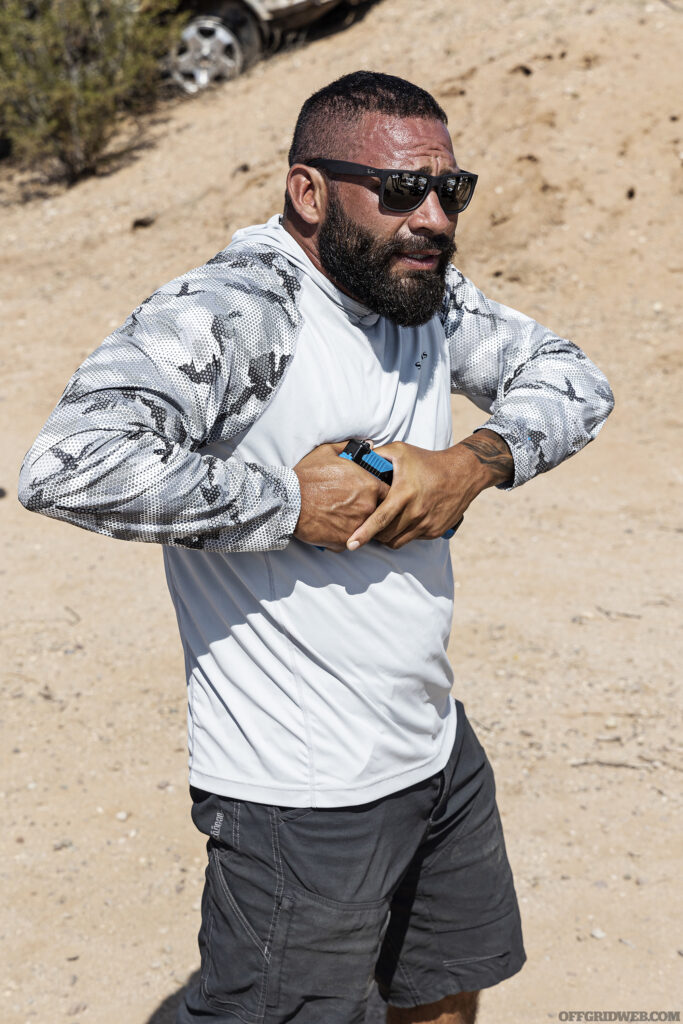
Above: Raul Martinez demonstrates two “off-body holster” methods to protect and control a firearm — thumb over bore and palm over bore — if you realize a hands-on fight is imminent.
Training began on a live-fire range, where each student learned how to deliberately induce a malfunction in his or her handgun. Why? If you’re about to get into a knock-down drag-out fight with someone, it’s surprisingly easy for your opponent to shoot you with your own gun — something we learned the hard way later with Simunition rounds — and putting it into a non-functional state temporarily might prevent that. Additionally, knowing how to induce a malfunction in your opponent’s gun while you’re grappling can put them at a huge disadvantage. We accomplished this by clamping the slide in a static position with our support hand before pressing the trigger. If the slide is pressed slightly out of battery, the gun won’t fire at all; if it’s held in place, the gun will fire one round but won’t eject it, resulting in a dead trigger. Racking the slide can clear the malfunction once you have control of the gun again.
Aside from the ability to induce malfunctions, gripping the slide with your support hand offers much better control over the firearm — Martinez calls this an “off-body holster” technique. Two methods were demonstrated: thumb over slide with elbows tucked in, and palm over slide with support side elbow up. The former keeps both arms and the gun tight against the body, making it almost impossible for an opponent to wrench the gun from your grasp. The latter allows you to use your elbow to protect your head from punches and create more defensible space. In either case, the trigger guard should be fully covered by your hands, and both hands should remain firmly on the gun. A similar grip around the slide and trigger guard can be used to forcibly “holster” an opponent’s gun during a fight, preventing them from getting a finger onto the trigger.
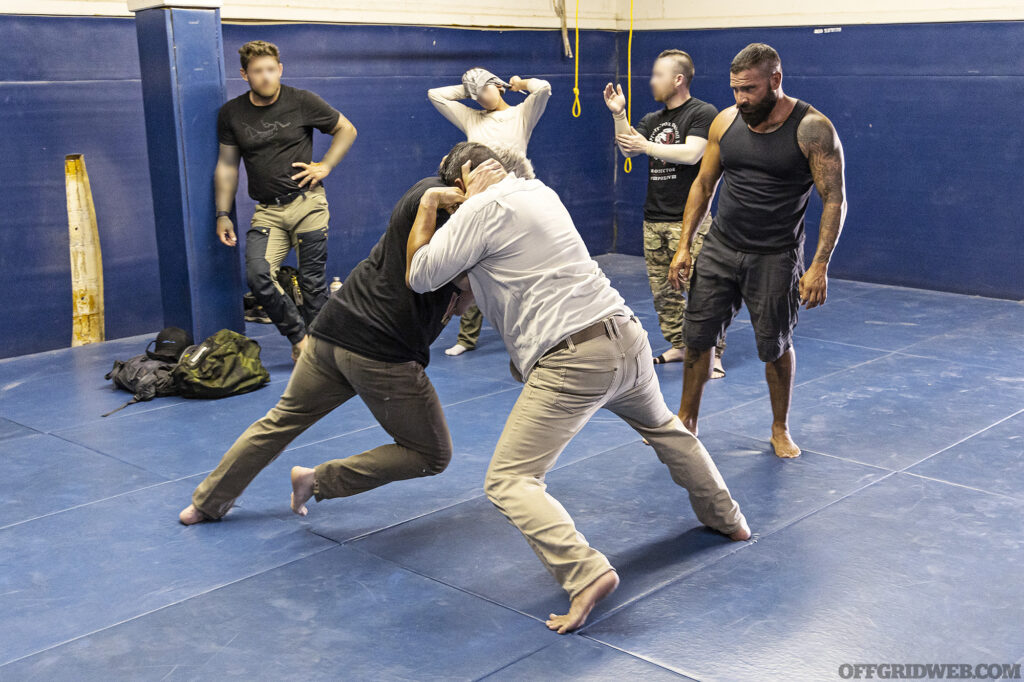
Above: After a few hours of grappling, every student was battered and exhausted. At this point, Martinez started adding Simunition training guns to the fray, dumping a whole new level of adrenaline into each fight.
After our brief live-fire segment, we headed inside and spent the next few hours grappling on padded mats. At first, we did hands-off, head-to-head drills to focus on footwork and learn how to push an opponent off balance solely with body weight. Next, we put on gloves and started punching our sparring partners as we grappled. Then, inert training guns were added to the mix, and students were forced to fight to maintain or take control of the weapon. For the final exercise, students paired up, stood head to head, and started grappling. At some point during the struggle, a training gun loaded with Simunition rounds was tossed into the fray, and both students dove for it. In some cases, the students struggled over the gun for an agonizing 30 seconds, but neither was able to shoot it; in other cases, one student took control of the gun immediately and shot their adversary at point blank — a painful but memorable lesson. We finished the Rogue Methods training block sore, bruised, and thoroughly winded, but it was a stark reminder of how challenging a contact-distance gunfight can be.
Closing Thoughts
With a wide variety of lessons on mindset, edged weapons, firearms, and tactics, the Protector Symposium 5.0 covered a lot of ground in only 72 hours. More importantly, we didn’t just listen to PowerPoint presentations or discuss these topics in the classroom — we experienced the drills and lessons firsthand. If you take the responsibility of being a protector seriously, you owe it to yourself and your loved ones to seek hands-on training from qualified instructors. It’s a worthwhile investment in a skill set that will leave you with far better options when disaster strikes than to simply call 9-1-1 and wait.
Sources
Protector Symposium
IG: @protector_nation
The post Protector Symposium 5.0 appeared first on RECOIL OFFGRID.
By: Patrick McCarthy
Title: Protector Symposium 5.0
Sourced From: www.offgridweb.com/preparation/protector-symposium-5-0/
Published Date: Wed, 12 Apr 2023 11:00:18 +0000
------------------------
Did you miss our previous article...
https://bushcrafttips.com/bushcraft-news/so-can-you-eat-frogs-for-survival
 What is BushcraftSurvival SkillsToolsVideosBushcraft CampsBushcraft KitsBushcraft ProjectsPrivacy PolicyTerms And Conditions
What is BushcraftSurvival SkillsToolsVideosBushcraft CampsBushcraft KitsBushcraft ProjectsPrivacy PolicyTerms And Conditions
